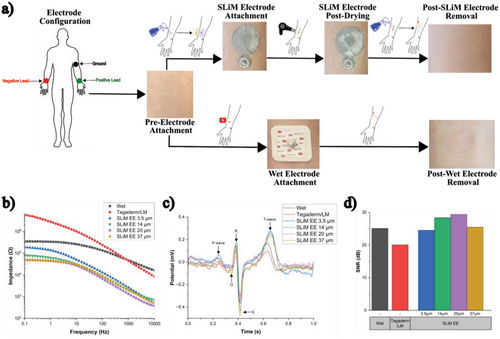New Applications for ELMNT® Liquid Metal Inks
February 01, 2024
ELMNT® Liquid Metal Inks have had many interesting applications. These include flexible hybrid electronics, resistive joule heating, inductive power, as well as flexible data transfer. New research has demonstrated the use of these innovative metal inks in applications that contact the human body, and in soft robotics. Contact us to learn more about how you can use ELMNT in your work.

Human skin is a complex organ. Having electrodes that can be compatible in a biological and a mechanical sense with skin, can be very useful in noninvasive medical monitoring of vital signs, as well as more complex electrophysiological signals. Researchers have even extended such electrodes to human machine interfaces for prosthetic control. These electrodes need to be flexible enough to maintain conformal contact with skin with no air gaps. This need is currently filled with wet electrodes (based on silver chemistries) which use adhesives to maintain skin contact. These adhesives and electrolytic gel have the potential to cause skin irritation, especially when injury or skin conditions may be present.
ELMNT Liquid Metal inks offer an interesting option in these epidermal electrode applications. Liquid metals offer a good combination of high conductivity (~3000S/cm), low modulus (0.5MPa), stretchability (150% at failure) and nontoxicity. Researchers at Miami University (OH) and the AFRL collaborated to combine biocompatible spider silk with printable liquid metal to yield an incredibly soft and scalable on-skin electrode that is strain-tolerant, conformable, and gentle on-skin . The electrodes were fabricated via blade coating ELMNT ink onto an electrospun spider silk mat. The researchers call these silky liquid metal (SLiM) electrodes. Their work found SLiM electrodes to over five times more breathable than commercial wet electrodes. The silk's intrinsic adhesion mechanism allows SLiM electrodes to avoid the use of harsh artificial adhesives, potentially decreasing skin irritation and inflammation over long-term use. These electrodes also provide comparable impedances to traditional wet and other liquid metal electrodes, offering a high-fidelity sensing alternative with increased wearer comfort. The researchers tested SLiM electrodes on a human subject successfully as well.

Image Caption: On-skin performance of silky liquid metal (SLiM) electrodes. a) Electrode configuration used for impedance and electrocardiography (ECG) measurement (left) and diagram of the attachment processes for both SLiM and commercial wet electrodes (right) including schematics and before and after images of the skin contacted with each electrode type. b) Impedance responses of commercial wet, Tegaderm/liquid metal (LM), and electrospun encapsulated (EE) SLiM electrodes measured on a human subject. c) Overlaid ECG signals displaying a single waveform captured by each of the tested electrodes. d) Signal-to-noise ratios (SNR) of the ECG signals measured by each of the tested electrodes.
The researchers found that the ELMNT based electrodes demonstrated lower skin impedance compared to commercial wet electrodes across the applicable frequencies for ECG, EEG, and EMG measurement, allowing for the same high-fidelity signal acquisition as that provided by commercial wet electrodes. They provide significant promise as a viable alternative for noninvasive health monitoring, with a strong clinical utility for sensitive skin variants such as burn victims, premature infants, and elderly patients.
Citation: Menke, M. A., Li, B. M., Arnold, M. G., Mueller, L. E., Dietrich, R., Zhou, S., ... & Sparks, J. L. (2023). Silky Liquid Metal Electrodes for On‐Skin Health Monitoring. Advanced Healthcare Materials, 2301811.
Electronic skins are also finding applications in bio-inspired robotics. These skins have various sensing capabilities such as changes in temperature and locomotion. GE Aerospace has developed a mobile inspection robot termed Sensiworm (Soft ElectroNics Skin-Innervated Robotic Worm), a highly intelligent, acutely sensitive soft robot that could serve as extra sets of eyes and ears for Aerospace service operators inside the engine. Such ‘soft’ robots can combine the ability to integrate sensors and actuators while navigating unusual and complex paths with compliant structures that are robust.
Researchers at SUNY Binghamton, GE Global Research Center and the AFRL combined ELMNT Liquid Metal Inks with direct-write printing technology on styrene-ethylenebutadiene- styrene (SEBS) and Thermoplastic Polyurethane (TPU) to create these soft robots. The printing and fabrication process developed in this work resulted in a conformable, stretchable, and reconfigurable electronic skin design for soft robotic sensing applications. The integration and operation was successfully realized into a sensiworm inspired soft robot for structural health monitoring.
Citation: Abbara, E. M., Alhendi, M., Al-haidari, R., Gee, N., Poliks, M. D., Boggs, E., ... & Tabor, C. E. (2023, May). Electromechanical and Thermal Characterization of Printed Liquid Metal Ink on Stretchable Substrate for Soft Robotics Multi-Sensing Applications. In 2023 IEEE 73rd Electronic Components and Technology Conference (ECTC) (pp. 426-431). IEEE.
Connect with us on Facebook, Twitter, LinkedIn, and Instagram.
Want to talk about how ELMNT's potential can be useful for your specific application? Contact us below or leave a comment!

